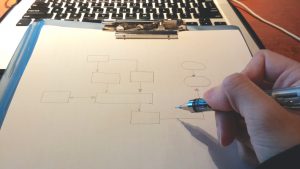
In computer programming, the designing of the software project comes after learning the programming language. Likewise, in Unit Two for English 301, we brainstormed and designed our LinkedIn profile and our formal report. Creating our LinkedIn profile is an important step towards presenting our professional selves to the world. Not only did we learn to design the profile in a way that is visually appealing, we had to ensure that the content of our profile is tailored to our intended audiences (in this case, our prospective employers and connections). The brainstorming and preparation process of the Formal Report taught a great deal about how to approach a large project, in a step-by-step manner.
LinkedIn Profile
Overall, the process of creating the LinkedIn profile was enjoyable and very different from creating profiles on other social media platforms. Specifically, LinkedIn has encouraged me to engage and present myself in a more professional manner, which is not a focus for other social media accounts. For example, having a professional profile photo is one of the most important element in a LinkedIn account, while photo quality is not important on a Facebook account. Although I am a photographer and have a few professional self-portraits on hand, I struggled to find a photo suitable for my LinkedIn profile because I had to ensure that the photo I chose conveys professionalism, from my outfit to my facial expression. The summary section required more work than I expected because, knowing that many LinkedIn users merely skim through profiles, I struggled to summarize all aspects of myself (i.e., my skills, experiences, personality, and goals) in less than a minute of my readers’ time. Overall, I was surprised that first impression and personal image are more important on LinkedIn than on any other social media platforms.
Before lesson 2:2, I thought LinkedIn was simply a platform where you present your resume, and potential employers would browse through profiles and contact you if they find you suitable for a position. I am fascinated to know that LinkedIn does much more than resume presentation, and that a successful profile requires active participation. I am excited to make the most out of my LinkedIn experience by participating in group discussions, making connections, and updating my profile with the projects I will be doing in school.
Brainstorming and preparing for the formal report
I had a difficult time coming up with a topic for my Formal Report. Although I wanted my topic to be about my workplace at Fido, I wasn’t sure how I could conduct a research without violating the company’s policies and the confidentiality of the customers and the staff team. Fortunately, I was able to formulate a research plan that does not involve the customers as research subjects. However, I will need to take great care in not interfering with store operations while I conduct my research. I will also need to remain vigilant on maintaining the confidentiality of the staff team, who will be my main research subjects, as the survey and interview questions requires their honest input on the current store situation and their work habits.
I find that having an outline for my formal report was extremely helpful in organizing my research. For example, with the outline, I was able to clearly plan and divide my research into areas of inquiry, and specify the the data collection methods I will be using for each of these areas. I am confident that the process of writing the formal report will go smoothly with the help of my outline.
Peer review on Formal Report Proposal
I am very impressed with Regina’s Formal Report Proposal. Specifically, she fulfilled the purpose of a proposal by keeping the proposal concise while providing ample information to persuade her intended audience into action. Her choice of words makes her proposal very easy to digest. Maintaining conciseness and using words tailored to the audience are both techniques I need to work on. Also, the topic she chose for her Formal Report and her research inquiries were very straightforward. After reviewing her proposal, I was inspired to further simplify the scope of my topic so I could strengthen the focus of my research. As a result, I have narrowed the scope of my research in the Formal Report Outline and stated my research inquiries with more clarity.
Peer review process
So far in this course, I have completed peer reviews for all the members of my writing team. All of their writings have a common strength: the effective choice of words and structure of sentences that make for an easy read. Perhaps due to the amount of academic papers I’ve written for my previous degree, I have a tendency to write complex (and sometimes run-on) sentences with excessive prepositions. Their writing pieces are useful reminders that I need to work on simplifying my sentences, and avoiding the use of unnecessarily complicated words.
Peer reviewing has made me more aware of who I am writing for. By reviewing my team’s writings from the perspective of an audience, I am able to take note of their writing style and techniques that make a piece of writings easy to read and understand. I also learned from their mistakes when I encounter parts of their writing that were difficult to absorb. Through peer reviewing, I am more conscious of how my writing can be made more suitable for my intended audience.
Word Document of Revised Formal Report Proposal: Formal Report Proposal
Link to my Formal Report Proposal Peer Review for Regina Lai: http://engl301.arts.ubc.ca/2016/10/09/peer-review-of-formal-report-proposal-for-regina-lai/
Link to the Peer Review of my Formal Report Proposal by Regina Lai: http://engl301.arts.ubc.ca/2016/10/10/peer-review-formal-report-proposal-2/
